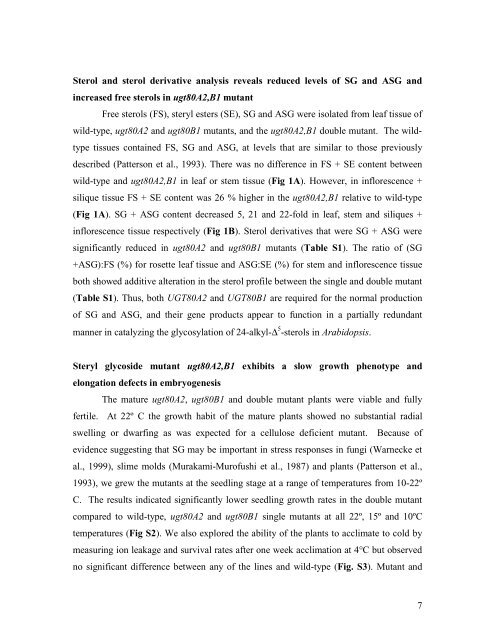1 Running head: Steryl glycoside mutants Name: Seth DeBolt ...
1 Running head: Steryl glycoside mutants Name: Seth DeBolt ...
1 Running head: Steryl glycoside mutants Name: Seth DeBolt ...
You also want an ePaper? Increase the reach of your titles
YUMPU automatically turns print PDFs into web optimized ePapers that Google loves.
Sterol and sterol derivative analysis reveals reduced levels of SG and ASG and<br />
increased free sterols in ugt80A2,B1 mutant<br />
Free sterols (FS), steryl esters (SE), SG and ASG were isolated from leaf tissue of<br />
wild-type, ugt80A2 and ugt80B1 <strong>mutants</strong>, and the ugt80A2,B1 double mutant. The wildtype<br />
tissues contained FS, SG and ASG, at levels that are similar to those previously<br />
described (Patterson et al., 1993). There was no difference in FS + SE content between<br />
wild-type and ugt80A2,B1 in leaf or stem tissue (Fig 1A). However, in inflorescence +<br />
silique tissue FS + SE content was 26 % higher in the ugt80A2,B1 relative to wild-type<br />
(Fig 1A). SG + ASG content decreased 5, 21 and 22-fold in leaf, stem and siliques +<br />
inflorescence tissue respectively (Fig 1B). Sterol derivatives that were SG + ASG were<br />
significantly reduced in ugt80A2 and ugt80B1 <strong>mutants</strong> (Table S1). The ratio of (SG<br />
+ASG):FS (%) for rosette leaf tissue and ASG:SE (%) for stem and inflorescence tissue<br />
both showed additive alteration in the sterol profile between the single and double mutant<br />
(Table S1). Thus, both UGT80A2 and UGT80B1 are required for the normal production<br />
of SG and ASG, and their gene products appear to function in a partially redundant<br />
manner in catalyzing the glycosylation of 24-alkyl-Δ 5 -sterols in Arabidopsis.<br />
<strong>Steryl</strong> <strong>glycoside</strong> mutant ugt80A2,B1 exhibits a slow growth phenotype and<br />
elongation defects in embryogenesis<br />
The mature ugt80A2, ugt80B1 and double mutant plants were viable and fully<br />
fertile. At 22º C the growth habit of the mature plants showed no substantial radial<br />
swelling or dwarfing as was expected for a cellulose deficient mutant. Because of<br />
evidence suggesting that SG may be important in stress responses in fungi (Warnecke et<br />
al., 1999), slime molds (Murakami-Murofushi et al., 1987) and plants (Patterson et al.,<br />
1993), we grew the <strong>mutants</strong> at the seedling stage at a range of temperatures from 10-22º<br />
C. The results indicated significantly lower seedling growth rates in the double mutant<br />
compared to wild-type, ugt80A2 and ugt80B1 single <strong>mutants</strong> at all 22º, 15º and 10ºC<br />
temperatures (Fig S2). We also explored the ability of the plants to acclimate to cold by<br />
measuring ion leakage and survival rates after one week acclimation at 4°C but observed<br />
no significant difference between any of the lines and wild-type (Fig. S3). Mutant and<br />
7

















